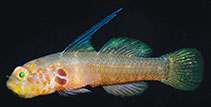| Family: |
Gobiidae (Gobies), subfamily: Gobiinae |
| Max. size: |
1.76 cm SL (male/unsexed) |
| Environment: |
reef-associated; marine; depth range 20 - 35 m |
| Distribution: |
Western Pacific: Papua New Guinea (Milne Bay). |
| Diagnosis: |
Dorsal spines (total): 7-7; Dorsal soft rays (total): 9-9; Anal spines: 1-1; Anal soft rays: 8-8; Vertebrae: 26-26. This species is distinguished by the following set of characters: D1 VI , D2 I,9, with first two spines filamentous; A I,8; pelvic fins relatively short, with longest rays falling well short of anal opening; segmented pelvic-fin rays are branched; pelvic-fin membrane and frenum fully developed; longitudinal scales 26; cephalic sensory pores include nasal pores (NA), anterior (AITO) and posterior (PITO) interorbital pores, supraotic pores (SOT), anterior otic pores (AOT), and upper and lower preopercular pores (POP). Colour in life generally semi-translucent pale brown with orange hue imparted by narrow orange margins of body scales; the first dorsal fin translucent yellowish, except elevated first two spines whitish; second dorsal, anal, and caudal fins are slightly yellowish with small orange-to-reddish spots; pelvic fins pale pinkish; pectoral fins translucent with pair of large brown spots separated by a narrow white band on base (Ref. 121769). |
| Biology: |
Specimens were obtained within about 150 m of each other on a gently sloping to nearly flat, silty-sand bottom in depths of about 20-35 m. They were invariably associated with an unidentified tubeworm species that constructs vertical, stick-like structures that project to a height of about 30 cm above the substrate. The worm tubes were variously populated with a wealth of encrusting, sessile invertebrates such as sponges, tunicates, hydrozoans, and bryozoans that provided shelter for the fish as well as small crabs and shrimps. We estimated about 20-30% of the worm tubes were inhabited by the gobies, which were mainly solitary, although rarely in pairs. The fish were usually observed perched among the sessile invertebrate growth, retreating to the interior of the worm tube via a variety of openings when disturbed (Ref. 114922). |
| IUCN Red List Status: |
Not Evaluated (N.E.) Ref. (130435)
|
| Threat to humans: |
harmless |
Source and more info: www.fishbase.org. For personal, classroom, and other internal use only. Not for publication.
